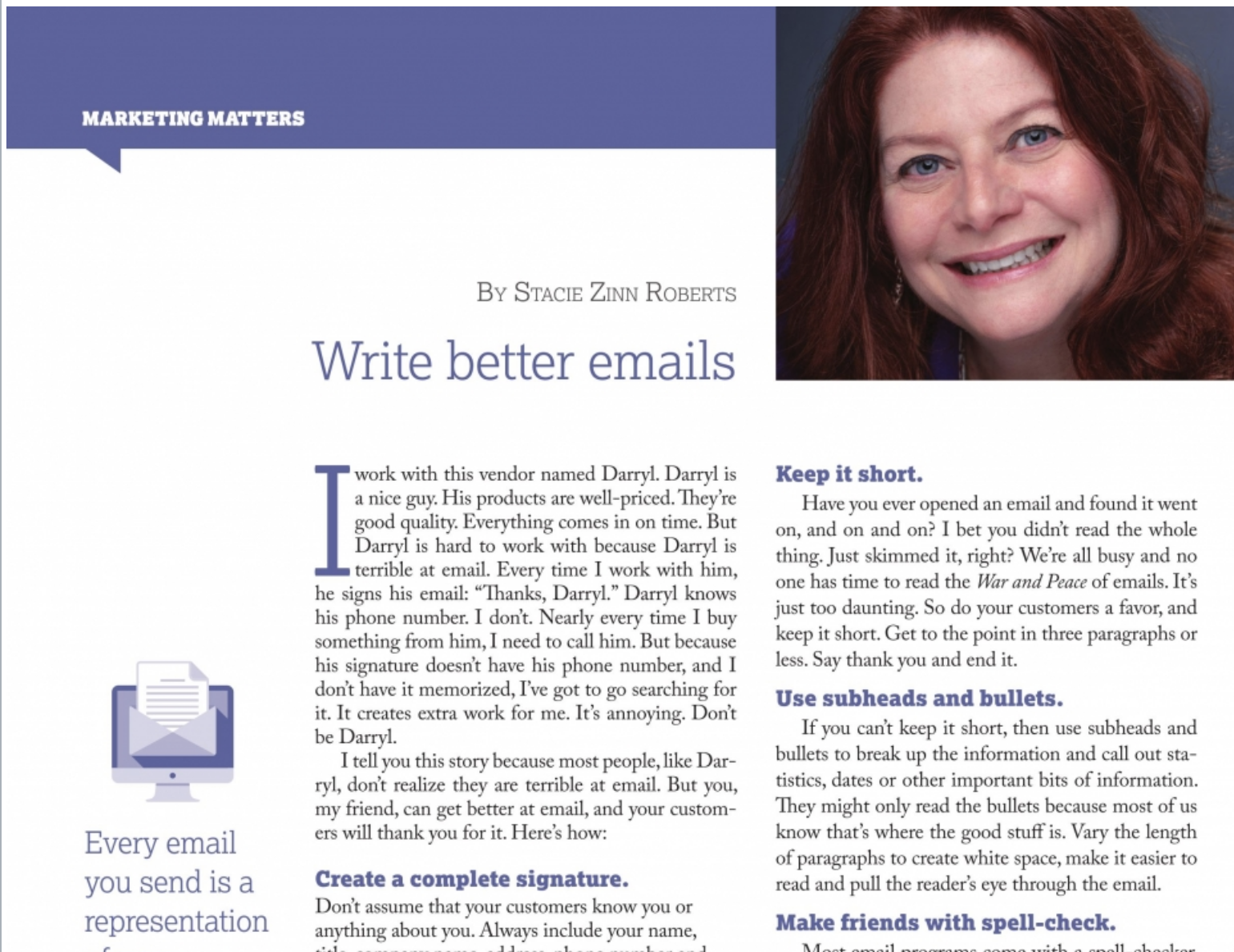I work with this vendor named Darryl. Darryl is a nice guy. His products are well-priced. They’re good quality. Everything comes in on time. But Darryl is hard to work with because Darryl is terrible at email. Every time I work with him, he signs his email: “Thanks, Darryl.” Darryl knows his phone number. I don’t. Nearly every time I buy something from him, I need to call him. But because his signature doesn’t have his phone number, and I don’t have it memorized, I’ve got to go searching for it. It creates extra work for me. It’s annoying. Don’t be Darryl.
I tell you this story because most people, like Darryl, don’t realize they are terrible at email. But you, my friend, can get better at email, and your customers will thank you for it. Here’s how:
Create a complete signature.
Don’t assume that your customers know you or anything about you. Always include your name, title, company name, address, phone number and email address. Add a link to your website and all of your social media channels too. To do this, create a standard email signature in your email software that automatically populates on the bottom of every email.
If this seems like overkill, consider the information you’re actually conveying. Using your full name lets the receiver know who you are. Maybe there are two men named Bob at your company. Your full name tells them you’re the right Bob. Your title tells the recipient that you are qualified to answer their questions. Your company name tells them who you represent. The address indicates if you are local to your customers. It gives them a clue to your time zone if you’re not local and a physical address in case they want to drop by with a basket of fruit. You never know! Include your phone number, so they can call you, and your email address, so they don’t have to look for it in the email thread. And the rest offers a myriad of ways to contact you, learn about your company and become a raving fan.
Keep it short.
Have you ever opened an email and found it went on, and on and on? I bet you didn’t read the whole thing. Just skimmed it, right? We’re all busy and no one has time to read the War and Peace of emails. It’s just too daunting. So do your customers a favor, and keep it short. Get to the point in three paragraphs or less. Say thank you and end it.
Use subheads and bullets.
If you can’t keep it short, then use subheads and bullets to break up the information and call out statistics, dates or other important bits of information.
They might only read the bullets because most of us know that’s where the good stuff is. Vary the length of paragraphs to create white space, make it easier to read and pull the reader’s eye through the email.
Make friends with spell-check.
Most email programs come with a spell-checker. In addition, there are several spell-check programs available for download. Grammarly offers free and paid versions (www.grammarly.com) that work as a Chrome extension to your email. I use them together to double-check my spelling.
Don’t type in ALL CAPS.
In the world of email, ALL CAPS is the equivalent of screaming at the email recipient. Not only is it rude, but a long string of capitalized words is almost impossible to read. Use ALL CAPS sparingly, for emphasis only, or NOT AT ALL because it sounds like your mom is scolding you.
Every email you send is a representation of you and your company. It’s marketing in its purest form. Make it easy for your clients and potential customers to do business with you. Follow these tips, then shoot me an email at stacie@whatsyouravocado.com to let me know about your progress.
This article originally ran in the February 2020 issue of Irrigation & Green Industry magazine, Marketing Matters column by Stacie Zinn Roberts.

Stacie Zinn Roberts is a nationally recognized, award-winning writer and marketing expert with more than 25 years of experience. She has won more than 40 national awards for her work including the United Nations Environmental Program for retail environmental marketing, as well as from organizations such at the Public Relations Society of America and the Turf & Ornamental Communicators Association. She’s written for industry publications such as Golf Course Management, Sports Turf, Golfdom and PR Daily. She spent eight years as the president and director of marketing for Environmental Turf, where she developed the branding for SeaDwarf Seashore Paspalum, the grass that eventually became the greens grass for the Rio Olympic Golf Course. Stacie served for six years on the Board of Directors of the Florida Turfgrass Association as Chair of the Research & Scholarship Committee where she worked closely with the scientists from the University of Florida’s turfgrass breeding program. Stacie founded What’s Your Avocado? Marketing & Public Relations in 2012.


Hello Stacie,
Thanks for your article about using an email signature.
I’m not currently working for a company but I am on the Board of Directors for the Skagit Community Foundation. I decided to give it a try today and see what kind of feedback I receive.
Hi Kim,
Please keep me posted. I’d love to know if the change makes an impact.
I went to the Foundation’s website. Looks like you help fund a lot of projects int he community.
I’d be happy to help the Board should you ever need marketing materials.
Good to hear from you!